Asko W6441WH, W6021, W6761, W6441 User Manual

USE AND CARE GUIDE
SAVE THESE INSTRUCTIONS FOR FUTURE REFERENCE
|
|
|
|
|
|
|
om |
|
|
|
|
TANT! |
|
fr |
|
||
|
|
|
|
ating |
||||
|
|
|
|
ormance |
|
the |
||
|
IMPOR |
|
|
operor |
|
|||
|
|
|
|
f |
|
|||
|
|
|
perf |
all |
it |
|
||
|
|
|
|
|
||||
|
best |
|
|
|
|
|
||
|
the |
, |
read using |
|
|
|||
|
|
ore |
|
|
|
|
||
To |
|
|
|
|
|
|
||
washer |
|
|
|
|
|
|
||
|
get |
bef |
|
|
|
|
||
your uctions. |
|
|
|
|
|
|
|
|
instr time |
|
|
|
|
|
|
|
|
|
first |
|
|
|
|
|
|
|
WASHER
CONTENTS
IMPORTANT SAFETY INSTRUCTIONS |
2 |
CHILD SAFETY FEATURES |
2 |
ASKO WASHER FEATURES |
3 |
INSTALLATION INSTRUCTIONS |
4 |
PREPARING THE LAUNDRY |
6 |
THE DETERGENT DRAWER |
8 |
DETERGENTS |
8 |
FABRIC SOFTENERS |
9 |
FABRIC DYEING |
9 |
RECOMMENDED WASH TEMPERATURES |
9 |
W6021 OPERATING INSTRUCTIONS |
10 |
W6441 OPERATING INSTRUCTIONS |
12 |
W6761 OPERATING INSTRUCTIONS |
15 |
CARE AND MAINTENANCE INSTRUCTIONS |
21 |
COMMON LAUNDRY PROBLEMS |
22 |
TROUBLESHOOTING |
23 |
ASKO PRODUCT WARRANTY |
25 |
INDEX |
26 |
Page 1

IMPORTANT SAFETY INSTRUCTIONS
To reduce the risk of fire, electric shock, or injury to persons when using your appliance, follow basic precautions, including the following:
♦Read all instructions before using the appliance.
♦Do not run appliance while you are out of the home.
♦Do not wash or dry articles that have been previously cleaned in, washed in, soaked in, or spotted with gasoline, dry-cleaning solvents, cooking oils, or other flammable or explosive substances because they give off vapors that could ignite or explode.
♦Do not allow children to play on or in the appliance. Close supervision of children is necessary when the appliance is used near children.
♦Before the appliance is removed from service or discarded, remove the door to the washing compartment.
♦Do not reach into the appliance if the drum is moving.
♦Do not install or store this appliance where it will be exposed to the weather.
♦Do not tamper with controls.
♦Do not repair or replace any part of the appliance or attempt any servicing unless specifically recommended in the user-repair instructions or in published user-repair instructions that you understand and have the skills to carry out.
♦Do not add gasoline, dry-cleaning solvents, or other flammable or explosive substances to the wash water. These substances give off vapors that could ignite or explode.
♦Under certain conditions, hydrogen gas may be produced in a hot water system that has not been used for 2 weeks or more. HYDROGEN GAS IS EXPLOSIVE. If the hot water system has not been used for such a period, before using a washing machine or combination washer-dryer, turn on all water faucets and let the water flow from each for several minutes. This will release any accumulated
hydrogen gas. As the gas is flammable, do not smoke or use an open flame during this time.
WARNING!
This appliance must be properly grounded.
GROUNDING INSTRUCTIONS
A) Grounding instructions for a grounded, cordconnected appliance
In the event of malfunction or breakdown, grounding will reduce the risk of electric shock by providing a path of least resistance for electric current. This appliance is equipped with a cord having an equipment-grounding conductor and a grounding plug. The plug must be plugged into an appropriate outlet that is properly installed and grounded in accordance with all local codes and ordinances.
WARNING!
Improper connection of the equipment-grounding conductor can result in a risk of electric shock. Check with a qualified electrician or service representative or personnel if you are in doubt as to whether the appliance is properly grounded.
Do not modify the plug provided with the appliance. If it will not fit the outlet, have a proper outlet installed by a qualified electrician.
B) Grounding instructions for a permanently connected appliance:
This appliance must be connected to a grounded metal, permanent wiring system, or an equipment-grounding terminal or lead on the appliance.
NOTE: This manual does not cover every possible condition and situation that may occur. Use common sense and caution when installing, operating, and maintaining any appliance.
CHILD SAFETY FEATURES
CHILD-SAFE DETERGENT DRAWER
ASKO washers have a child-safety catch on the detergent drawer that can be engaged to prevent a child from opening the drawer and possibly coming into contact with the detergent or fabric softener. Refer to page 8 for instructions on how to engage the child-safety catch.
CHILD-SAFE TEMPERATURE KNOB
Model W6021 has a child-safety catch that can be engaged to prevent children from tampering with the temperature knob. The catch is located below the temperature knob behind the edge of the control panel. To engage it, insert a flathead screwdriver in the slot on the catch. Press upwards as you turn the catch clockwise. When you release the catch it should protrude slightly below the control panel.
Once the catch is engaged, you must hold it up as you turn the temperature knob to the desired setting.
CHILD-SAFE START
You can program Models W6441 and W6761 not to start unless the Start button is held down for three seconds.
Page 2
This is to prevent children from inadvertently starting the machine. Refer to the operating instructions for these models to program this safety feature.
MORE CHILD-SAFETY TIPS
♦Laundry detergents are corrosive, so always keep them out of reach of children.
♦Should a child swallow detergent, give plenty to drink immediately, i.e., one or two glasses of milk or water. Do not try to induce vomiting. Seek medical advice immediately: 1-800-POISON1
♦Always close the door and start the appliance as soon as you put in the detergent.
♦Always turn the power off to the machine when it is not in use.
♦Always keep small children away from the machine when it is open. There may be some detergent residue left inside the machine.
♦If laundry detergent gets in someone’s eyes, rinse them with plenty of water for at least 15 minutes.
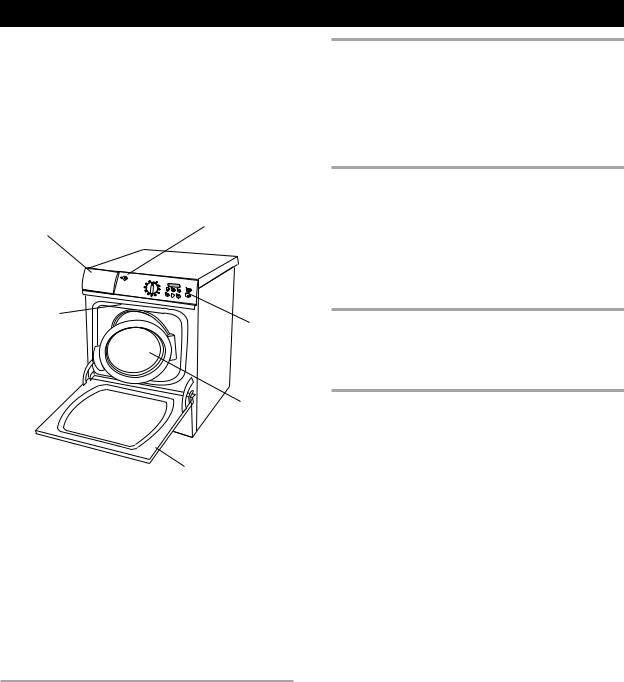
ASKO WASHER FEATURES
Your new energy-efficient ASKO washer is designed to give you maximum cleaning performance using less water, energy and detergent. To make the most of the washer’s functions and features, we recommend that you read this manual carefully before using your machine for the first time. For operating instructions, refer to pages 10 through 20.
Below is an illustration of the external parts and features of your ASKO washer.
Detergent and Fabric
Power
Softener Dispenser
Button
E |
2h |
Type Plate |
|
|
(with Type |
Control |
|
and Serial |
||
Panel |
||
Number) |
||
|
||
|
Glass |
|
|
Door |
|
|
Outer Door |
|
|
(W6441 and W6761) |
SENSOR LEVEL CONTROL (SLC)
ASKO washers do not need high, medium, or low water level settings to compensate for different sized loads. ASKO units have a consumption sensor— Sensor Level Control— that ensures the correct amount of water is pumped into the machine for any size load. It even compensates for fabric saturation, letting in more water if needed. This eliminates worry about selecting the right water level setting for each laundry load.
TEMPERATURE CONTROL
Because wash water temperature is a major factor in getting laundry clean, ASKO washers have built-in heating elements and a sensor that keeps the temperature to within +/-1° F of the selected program temperature.
ASKO washers are programmed not to advance in a cycle until the selected water temperature is reached, so the length of the cycles may vary, depending upon the household cold water temperature, the amount of laundry in the washer, and the wash temperature setting.
ENZYME STEP
To successfully remove all dirt and stains from fabric, the enzymes in your detergent need to work at a temperature between 105° and 140° F for a longer time period. This longer wash cycle gives the enzymes in the detergent ample time to remove stains, eliminating the need for stain sprays and spot removers.
MORE RINSE CYCLES
Most washers have only two or three rinse cycles; some have an option to add a fourth. ASKO washers have five rinses and a Super Rinse option that adds two more. ASKO washers get the soil and detergent out of your laundry that most other washers leave in. That’s why your whites will remain white and your colored fabrics will remain bright.
SUPER RINSE OPTION
This option is designed for people with sensitive skin or who are allergic to detergents. It can also be used for large, heavily soiled loads.
SPIN OPTIONS
ASKO washers have faster spin speeds than most other washers, which may decrease the time it takes to dry your laundry. The spin speeds range from 400 rpm to 1600 rpm, depending on the model. You can also turn the spin cycle off.
Page 3
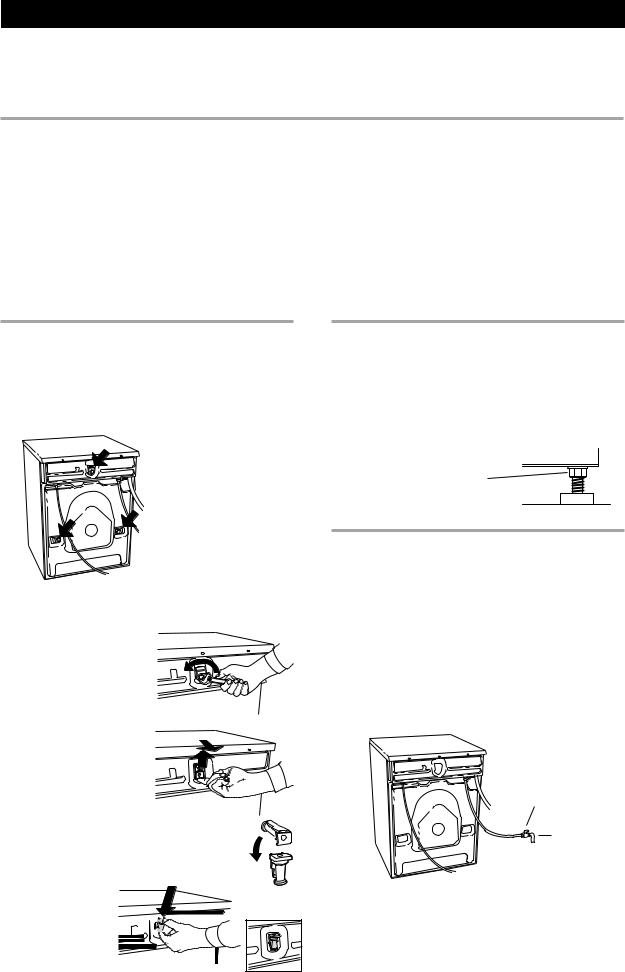
INSTALLATION INSTRUCTIONS
Read these instructions carefully and completely before you install the machine. The installation should be carried out by a qualified person who is familiar with all local codes and ordinances for electrical and plumbing connections.
IMPORTANT NOTE:
Cosmetic damage must be reported to your dealer within five days from the date of purchase. After unpacking the washer, thoroughly check the unit for cosmetic damage.
SPECIFICATIONS
Height |
33-1/2”–34-1/2 (850–876 mm) |
Width |
23-7/16” (595 mm) |
Depth |
W6761: 23-7/16" (595 mm) |
|
W6021/W6441: 24-7/16” (620 mm) |
Weight |
167 lbs. (73 kg) |
Rated load |
See data plate |
Supply voltage |
Single-phase 230 V, 60 Hz |
Heating element |
2000 W |
Fuse |
15 A (2 internal fuses) |
Drum and Barrel |
Stainless steel |
Outer casing |
Stove-enamelled hot-dipped |
|
galvanized steel or stainless steel |
Mounting |
Four adjustable rubber-covered |
|
feet |
Inlet supply hose |
5 ft. (1.5 m) PEX tubing with |
|
brass ferrules |
Supply pressure |
15–142 PSI |
Outlet hose |
5.5 ft. (1.7 m) polypropylene hose, |
|
3/4” ID |
REMOVING THE SHIPPING SUPPORTS
The machine is transported with three shipping supports, as illustrated below. These supports hold the tub in place during shipment. When you unpack the machine, you must remove these supports.
You must remove the shipping supports before you install the washer.
To remove the shipping supports, follow the instructions below:
1. |
Unscrew the 5/8” (12 |
|
|
mm) bolts holding the |
|
|
supports in place and |
|
|
remove the bolts. |
|
2. |
Push the rubber spacer |
2 |
|
up then pull it out of the |
1 |
|
slot. |
|
|
|
3.Rotate the spacer so that the extruded end points toward the machine.
4.Insert it into the
slot and push 
 down to lock it
down to lock it 




 into position.
into position. 





LEVELING THE MACHINE
It is important that the machine is level so it won’t vibrate excessively during the spinning cycles. Each foot on the washer is adjustable, so you can level the washer on any surface. Once it is level, securely tighten the lock nuts on the feet to prevent excessive vibration during the spin cycles.
Be sure to tighten the lock nuts securely when you level the machine.
WATER SUPPLY CONNECTION
Because ASKO washers have their own heating element, you only need to have a cold water inlet. The connection should be made by someone who is sufficiently skilled. Use the hose supplied with the washer. (The inlet hose is marked for proper connections.)
Water pressure must be in the range of 15–146 PSI.
A tap should be fitted on the water supply pipe.
If a new supply pipe has been installed for the washer, it should be flushed thoroughly to remove any foreign particles that might clog the strainer in the water inlet.
Tap
Cold water supply
NOTE: If unit is installed on a second story, follow local building codes. We recommend a drip pan be installed.
Page 4
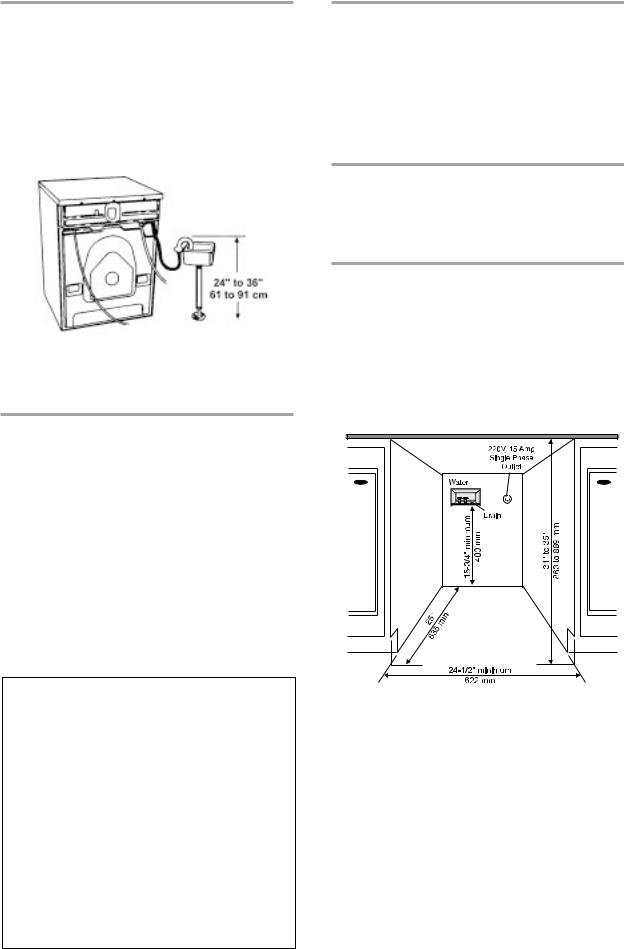
DRAIN OUTLET CONNECTION
The machine is supplied with the outlet hose already attached. The hose should be extended over a suitable sink edge or drain pipe at a height of 24” to 36” (610 mm to 914 mm) above the bottom of the unit. (The lower height is preferable.) Make sure that the hose is not kinked.
NOTE: If the hose is extended, the internal diameter of the coupling must not be less than 1/2”.
FREESTANDING INSTALLATION
The washer can be placed next to the dryer. It is essential that the machine is leveled and the locknuts tight to prevent excessive vibration during the spin cycles. Also be sure to leave a minimum of 1/2” (12 mm) of space between the washer and the dryer.
The height adjustment for the washer is 33-1/2” to 34-1/2” (850 mm to 876 mm). Do not raise it higher than 34-1/2”.
WARNING! Do not extend the drain hose higher than
36” (914 mm) from the bottom of the unit.
ELECTRICAL CONNECTIONS
The machine is delivered ready-fitted with a plug and is intended for connection to an ASKO Dryer, which is equipped with a matching receptacle. The plug supplied with the washer can only be used with an ASKO Dryer. If the washer is used separately or with another dryer, it must be on a separate 220 V single-phase circuit.
If the machine is to be used in a wet area, the supply must be protected by a residual current device.
As supplied: |
230 V, 60 Hz |
|
2000 W heating element |
|
15 A fuse required |
WARNING! Connection to a permanently wired supply point must be made only by a qualified electrician.
GROUNDING INSTRUCTIONS
This appliance must be grounded. In the event of malfunction or breakdown, grounding will reduce the risk of electric shock by providing a path of least resistance for electric current. This appliance is equipped with a cord having an equipment-grounding conductor and a grounding plug. The plug must be plugged into an appropriate outlet that is properly installed and grounded in accordance with all local codes and ordinances.
WARNING! Improper connection of the equipment-grounding conductor can result in a risk of electric shock. Check with a qualified electrician or serviceman if you are in doubt as to whether the appliance is properly grounded.
Do not modify the plug provided with the appliance. If it will not fit the outlet, have a proper outlet installed by a qualified electrician.
STACKED INSTALLATION
ASKO washers should never be stacked on a counter or a dryer. You can, however, stack an ASKO dryer on an ASKO washer. Refer to your Dryer Use and Care Guide for instructions on how to do this.
BUILT-IN INSTALLATION
ASKO washers can be installed beneath a cabinet or worktop with a height of 34-1/2” ( 876 mm). There must be a gap of about 1/2” (12 mm) all around the machine, including between the rear edge of the machine top panel and the back wall. The opening width must be at least 24-1/2” (622 mm).
Space must also be available for the inlet and drain hoses. See the diagram below for measurements and positions.
If the drain outlet is higher than 24”, the connections will need to be recessed.
Page 5

PREPARING THE LAUNDRY
We believe ASKO washers clean better than any other washer available on the market. With proper attention to how you prepare your laundry items for washing and drying, your wardrobe and linens will look like new for years.
SORTING THE LAUNDRY
Properly sorting your laundry is a very important factor in ensuring that your clothing and linens look new for a long time. Another important factor is properly following the care label instructions (see next page).
Below are some basic rules for sorting your laundry:
Sort by
1.Fabric color
Whites; pastels and medium colors; bright colors; dark colors
2.Amount of soil
Heavily soiled items should be washed separately from lightly soiled items.
3.Fabric Type
Delicates should be washed separately. You should also consider separating fabrics that tend to shed lint (e.g., cotton, chenille, and terrycloth) from fabrics that attract lint (e.g., permanent press, corduroy, velveteen, flannel and synthetics).
IMPORTANT NOTE:
If the care label says "Wash Separately," the fabric is likely to lose color (excess dye) for the first few washings. To minimize the possibility of the color transferring to white or lighter colored items, wash new colored garments with items of similar color or separately. Bright reds and oranges on cottons are the dyes most likely to transfer colors to the wash load. Fluorescent colors should always be washed separately.
RECOMMENDED LOAD SIZES
To reduce wrinkling, you should determine the load size based on the type(s) of fabrics being washed. The chart below gives recommended load sizes for different fabrics.
Load Size |
Fabrics |
Full |
Cotton, linen |
|
|
Half |
Perm press, synthetics, acrylics |
|
|
Third |
Special finish cottons, machine |
|
washable wool, silk, acetates |
|
|
Cotton and Linen Fabrics
These items should be washed in full loads because the tumble action of the tub along with the gentle rubbing and lifting and falling movement of the clothes gives the best cleaning result.
Permanent Press Fabrics
These items need more room to move freely during washing for the most wrinkle-free results. Therefore, fill the machine only half full for permanent press loads. These items should have only a brief spin cycle and they should be removed promptly from the washer and put directly into the dryer or hung to dry.
Delicate Fabrics
More delicate fabrics, such as machine washable wool and silk, should only be washed in one-third size loads for the best results.
ADVICE FOR PERSONS WITH SENSITIVE SKIN
ASKO washers are ideal for people allergic to detergent. Our Heavy, Normal and Light wash programs have five rinse cycles and a Super Rinse option that adds two more rinses. This ensures that all the detergent residue is rinsed out of your laundry.
As an extra precaution, you should use mild detergents and be careful not to use too much.
GENERAL LAUNDRY ADVICE
♦Always follow the care label instructions (see page 7).
♦Remove any sharp ornaments, pins or buckles to prevent snags.
♦Empty pockets and turn them inside out.
♦Close zippers and hooks to prevent snagging.
♦Tie sashes and strings to prevent tangling.
♦Mend any small rips to prevent them from enlarging.
♦Turn colored cotton garments, velvet and finer knitwear inside out before washing.
♦Turn delicate items, sweaters and T-shirts inside out to prevent pilling and to protect the prints.
♦Prewash severely soiled items.
♦Wash colored fabrics separately the first time.
♦Thoroughly rinse down items, such as comforters (Super rinse).
♦Use fabric softener to eliminate static electricity in synthetic garments and to soften cotton.
Page 6
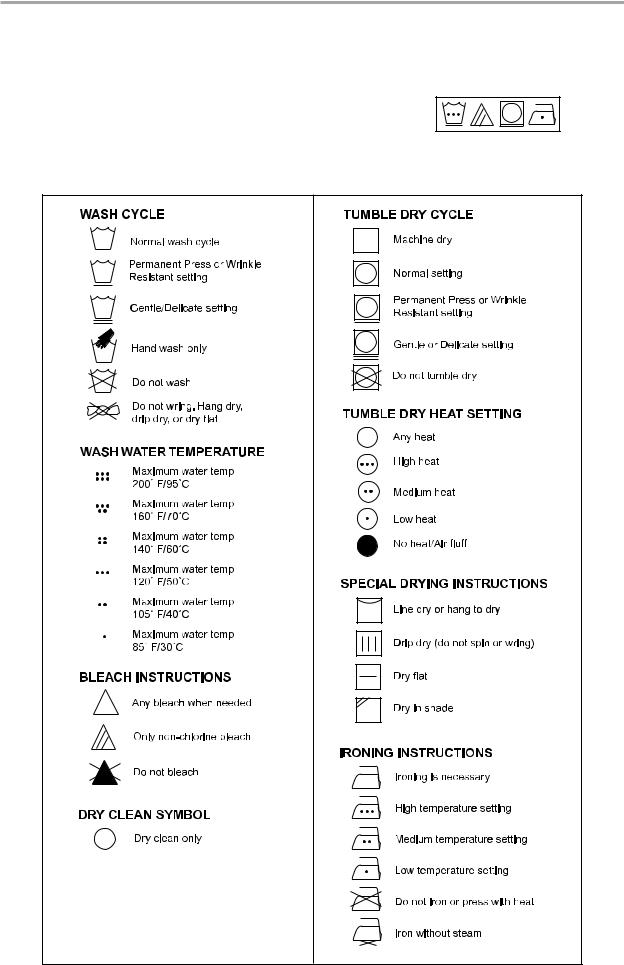
CARE LABEL INSTRUCTIONS
Most clothes and other washable items have permanent care labels. Read these labels carefully! Care label instructions and warnings should be followed for the best cleaning results.
The table below defines the symbols used on fabric care labels. (NOTE: Some manufacturers may use slightly different symbols.)
As an example, the symbols in the label illustrated below mean: wash in warm water on permanent press setting. Use non-chlorine bleach. Dry on permanent press setting. Iron on low temperature setting.
CARE LABEL SYMBOLS
Page 7
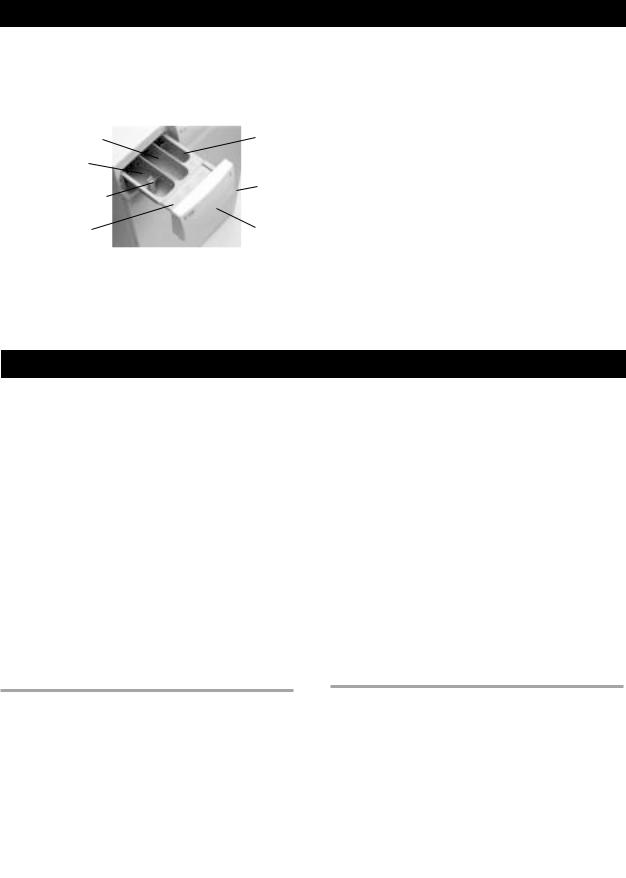
THE DETERGENT DRAWER
The detergent drawer on ASKO washers automatically dispenses the detergent and fabric softener at the appropriate times. Simply pour the measured amounts of detergent and softener into the proper compartments (as illustrated) and close the drawer.
Prewash
detergent |
Fabric |
|
softener |
||
Main wash |
||
Child- |
||
detergent |
||
Liquid detergent |
safety |
|
catch |
||
partition (see below) |
||
|
||
Control Button |
Pullout |
|
Definitions |
handle |
NOTE: To avoid oversudsing, do not put detergent in the prewash compartment unless you are using one of the Heavy wash programs which has a prewash cycle.
Control Button Definitions
Inside the detergent drawer is a plate that illustrates the buttons on the control panel and defines each button. Refer to the “Operating Instructions” in this guide for your specific model for more details regarding the control buttons.
Child-Safety Catch
All ASKO washers have a child-safety catch on the detergent drawer that can be engaged to prevent a child from opening the drawer and possibly coming into contact with the detergent or fabric softener.
The safety catch is the red plastic piece on the back right side of the pull-out handle. To engage the catch, open detergent drawer a little then pull the catch forward and release it. Once the catch is engaged, you must push it to the left each time you open the detergent drawer.
To disengage the catch, push it to the left then back.
DETERGENTS
Laundry detergents are available in low-, normaland high-sudsing formulas. A detergent´s ability to clean is not relative to the amount of suds it produces. Excess suds in a front-loading washer actually interfere with the cleaning because they cushion the tumbling action. Also, high-sudsing detergents are more difficult to completely rinse out.
The use of anything other than a low-sudsing detergent can cause severe oversudsing, which could cause suds to backup through the detergent compartment and run down the front of the washer onto the floor. If oversudsing occurs, run the wash through one or more rinse programs until all items are thoroughly rinsed. Remove the laundry then run the washer through a Normal wash program to get rid of any remaining detergent.
We recommend that you don’t use bleach in your ASKO washer. The tumbling wash action, temperature control options, extended wash times and proper amount of detergent are sufficient to remove most stains.
LIQUID DETERGENTS
We don’t recommend liquid detergents because they tend to produce more suds than powder detergents when used in water temperatures of 150° F or higher. If you should try a liquid detergent, start
with a very small amount, such as
1 to 2 tablespoons. Also, liquid detergent can be used for all programs without prewash, so add it into the main wash compartment.
Should you prefer to use a liquid detergent, we have provided a partition piece with the detergent
drawer specifically for use with liquid detergents. Insert the partition in the slot at the back of the main wash compartment before you pour in the liquid detergent.
NOTE: The partition piece is packaged under the detergent drawer.
Page 8
RECOMMENDED POWDER DETERGENTS
ASKO washers use 50% to 75% less detergent than most other washers. This is because of their low water consumption and the fact that all the wash water is repeatedly circulated through the laundry, ensuring that all the detergent is fully utilized. We recommend that you use powder detergents made specifically for frontloading washers. These are sometimes called HE (HighEfficiency) detergents. Listed below are some lowsudsing powder detergents that have been successfully tested in ASKO washers:
♦ |
Fab |
♦ |
All |
♦ |
Fresh Start |
♦ |
Amway SA8 |
♦ |
Tide HE |
♦ |
Wisk HE |
We recommend that you do not use any powder detergent that doesn’t wash completely out of the detergent drawer.
AMOUNT OF DETERGENT TO USE
The amount of detergent needed varies among the different brands, but for most detergents, you need only one or two tablespoons. Using too much detergent can result in detergent residue being left in your clothes, which can cause them to appear gray or dingy. You should start with a small amount of detergent and increase it only if the cleaning results are unsatisfactory.
Additionally, you should never put detergent in the prewash compartment unless you are using a wash program that has a prewash cycle. This could cause excess foaming, which could damage the machine.
The amount of detergent needed can also depend on the hardness of the water in your area. See the “Detergent Amounts Based on Water Hardness” section on the next page for more details.

Detergent Amounts Based on Water Hardness
The amount of detergent needed can vary due to differences in water hardness. To determine the water hardness in your area, contact your local water utility or area water softening company. The harder the water, the more detergent you may need. Refer to the chart below for the recommended detergent amounts based on water hardness. Remember, you should adjust the amount of detergent you use by small amounts until you find the correct amount.
Note that 12 grains and higher is extremely hard water
and detergent alone may not be enough. You may need to use a water softener to maximize the performance of your washer. Also, in areas with extremely hard water (9+) you may need to wash at lower temperatures to prevent hard water deposits from forming in the tank and wash system.
Different brands of detergent have different amounts of phosphorous for softening water. If you have hard water and use a detergent with less than 8.7% phosphorous content, you may need to use more detergent or use a detergent with a higher phosphorous content.
Recommended Detergent Amounts Based on Water Hardness
|
Detergent Amounts |
|
Water Hardness |
Prewash |
Main Wash |
|
|
|
Soft (0-3 grains per gal.) |
1 teaspoon |
1 to 1-1/2 tablespoons |
Medium (4-8 grains per gal.) |
1 teaspoon |
1 to 2 tablespoons |
Hard (9+ grains per gal.) |
1 teaspoon |
2 to 3 tablespoons |
|
|
|
FABRIC SOFTENERS
Fabric softeners are available in several concentrations. We recommend that you use only two tablespoons of
fabric softener. If more softening is desired, try adding slightly more the next time.
FABRIC DYEING
To dye fabrics in your washing machine, pour the dye directly into the drum, not in the detergent compartment. Select Normal wash with the Super Rinse option and use the temperature recommended on the dye package. If you’re dyeing polyester, select a spin speed of 800
rpm.
After you have removed the dyed items, be sure to clean the drum before you wash a load of laundry. Do this by running the empty machine through a Normal wash program using the normal amount of detergent.
RECOMMENDED WASH TEMPERATURES
Different fabrics require different wash temperatures. The table below gives recommended wash temperatures for different fabrics as well as recommended programs, load
sizes, and spin options. These are only suggestions. We recommend that you always refer to the care label instructions (see page 7).
|
Wash |
Wash |
Load |
Spin |
Fabric Type |
Temp. |
Program |
Size (1) |
Options (2) |
White cotton w/out elastic |
140–205° F |
Normal |
Full |
Long spin, high rpm |
and/or decorative trim |
|
|
|
|
White cotton w/elastic |
120–140° F |
Normal |
Full |
Long spin, high rpm |
and/or decorative trim |
|
|
|
|
Colored cotton |
120–140° F |
Normal |
Full |
Long spin, high rpm |
Linen (white and colorfast) |
120–140° F |
Normal |
Half |
Short spin, low rpm |
Cotton/polyester blends |
105–120° F |
Normal/Permanent press |
Half |
Short spin, low rpm |
Polyester/acrylic blends |
105–120° F |
Normal/Permanent press |
Half |
Short spin, low rpm |
Rayon and acetate |
105° F |
Delicate/Wool |
Half |
Short spin, low rpm |
Washable silk and nylon |
85° F (cold) |
Delicate/Wool |
Third |
Short spin, low rpm |
Washable wool and |
85–105° F |
Delicate/Wool |
Third |
Short spin, low rpm |
wool blends |
(cold) |
|
|
|
|
|
|
|
|
Handwash wool & silk (3) |
85° F (cold) |
Delicate/Wool |
Third |
Short spin, low rpm |
|
|
|
|
|
NOTES:
(1)The load size should be determined by the type of fabric being washed. (See page 6.)
(2)Spin speed options are not available on all models.
(3)Some hand-washable wool and silk items should not go through a spin cycle. These items should be removed from the washer then pressed out in a terry towel to remove excess water before being hung up or laid flat to dry.
Page 9
